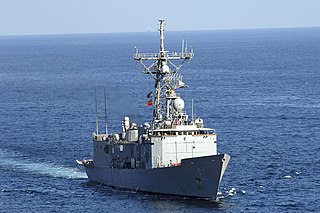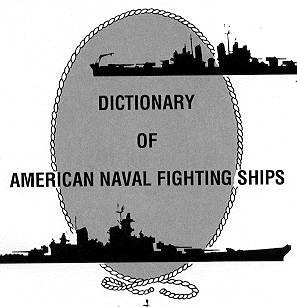
USS Chung-Hoon (DDG-93) is an Arleigh Burke-class Aegis destroyer serving in the United States Navy (USN). Chung-Hoon was named in honor of Rear Admiral Gordon Pai'ea Chung-Hoon (1910–1979), recipient of the Navy Cross and the Silver Star.

USS Kearsarge (LHD-3) is the third Wasp-class amphibious assault ship of the United States Navy named in honor of USS Kearsarge, a sloop-of-war that gained fame hunting Confederate raiders during the American Civil War. The sloop was named for Mount Kearsarge in New Hampshire. She is the fifth ship to be so named as such, but fourth overall, as the third was renamed the Hornet (CV-12), after the first Hornet (CV-8) was sunk, and served during the remainder of World War II.

USS Enterprise (CVN-65), formerly CVA(N)-65, is a decommissioned United States Navy aircraft carrier. She was the world's first nuclear-powered aircraft carrier and the eighth United States naval vessel to bear the name. Like her predecessor of World War II fame, she is nicknamed "Big E". At 1,123 ft, she is the world's longest naval vessel ever built. Her 93,284-long-ton displacement ranks her as the 12th-heaviest carrier, after the 10 carriers of the Nimitz class and the USS Gerald R. Ford. Enterprise had a crew of some 4,600 service members.

USS New York (LPD-21) is a San Antonio-class amphibious transport dock and the fifth ship of the United States Navy to be named after the state of New York.

USS Dubuque (LPD-8), an Austin-class amphibious transport dock, is the second ship of the United States Navy to be named for the city of Dubuque, Iowa.

USS Nashville (LPD-13), an Austin-class amphibious transport dock, was the third ship of the United States Navy to be named for the capital city of Tennessee. Her keel was laid down on 14 March 1966 by the Lockheed Shipbuilding and Construction Company of Seattle, Washington. She was launched on 7 October 1967 sponsored by Mrs. Roy L. Johnson, and commissioned at Puget Sound Naval Shipyard, Bremerton, Washington, on 14 February 1970 with Captain Frank R. Fahland in command.

USS Shoup (DDG-86) is an Arleigh Burke-class destroyer in the United States Navy. The ship is named for Medal of Honor recipient General David M. Shoup, the 22nd Commandant of the Marine Corps.

USS Ingraham (FFG-61), the last American Oliver Hazard Perry-class guided missile frigate to be built, was the fourth ship of the United States Navy to be named for Captain Duncan Ingraham (1802–1891).

The Medical Corps of the United States Navy is a staff corps consisting of military physicians in a variety of specialties. It is the senior corps among all staff corps, second in precedence only to line officers. The corps of commissioned officers was founded on March 3, 1871.

USS High Point (PCH-1) was a High Point-class patrol craft of the United States Navy, and was launched 17 August 1962 by J.M. Martinac Shipbuilding Corp. in Tacoma, Washington as a sub-contractor to Boeing in Seattle, Washington at a cost of $2.08 million, together with Vickers, Inc. Marine and Ordnance Department in Waterbury, Connecticut, which provided hydraulic components and controls. Electronic equipment aboard, including automatic stabilization equipment, dead reckoning navigation system, was developed and manufactured by the United Aircraft Corp. Hamilton Standard Division.

USS Haven (AH-12) was the lead ship of her class of hospital ships built for the U.S. Navy during World War II. Laid down as SS Marine Hawk, she was transferred from the Maritime Commission for conversion to a hospital ship, and served in that capacity through the end of the war. She was redesignated APH-112 in June 1946 for participation in Operation Crossroads, returning to her original AP-12 designation in October 1946. Haven participated in the Korean War and eventually ending her military career acting as a floating hospital in Long Beach, California. She was later converted to a chemical carrier and scrapped in 1987.

USS San Diego (LPD-22), a San Antonio-class amphibious transport dock, is the fourth ship of the United States Navy to be named for San Diego, California.

USS Rockbridge (APA-228) was a Haskell-class attack transport of the VC2-S-AP5 model in the United States Navy during World War II and the years following. She was named for Rockbridge County in Virginia.

USS Fitzgerald (DDG-62), named for United States Navy officer Lieutenant William Charles Fitzgerald, is an Arleigh Burke-class destroyer in the US Navy.
USAT J. W. McAndrew was a Type C3-P&C troop ship for the United States Army during World War II.

USS Portland (LPD-27) is a San Antonio-class amphibious transport dock ship of the United States Navy, named after the U.S. city of Portland, Oregon.




















